EDITOR’S NOTE: Traveleater Jenny Han shares with us 10 dishes you need to try on your next visit to Bali, Indonesia.
With its unique and delightful array of flavors, it isn’t surprising that people who travel to Bali rave about the island’s local food.
This is partially due to the fact that the Indonesian food in Bali is very different from the rest of the country. With a predominantly Hindu population, you can enjoy pork dishes in Bali that you wouldn’t normally find in other parts of Indonesia.
This province offers so much in the way of interesting culture and cuisine that it can be difficult to know exactly which dishes to try to ensure that you’ve tried the best.
To help you make the most of your Bali experience, here’s a guide to ten traditional Balinese dishes that you absolutely must try when you visit Bali.
BALINESE FOOD QUICK LINKS
To help you with your Bali trip planning, we’ve compiled links to recommended hotels, tours, and other travel-related activities here.
HOTELS
Recommended hotels in Canggu, one of the coolest areas to stay in Bali.
- Luxury: COMO Uma Canggu
- Midrange: Kano Canggu
- Budget: Tribal Bali
TOURS
- Balinese Food Tours: Food and Drinking Tours in Bali
- Balinese Cooking Classes: Cooking Classes in Bali
OTHER SERVICES
- Visa Services
- Travel Insurance (with COVID cover)
- Airport Transfers
- Private Car Charter
- Motorbike Rental
- Indonesia eSIM
UBUD & BALI TRAVEL GUIDE
Before traveling to Bali, be sure to check out our detailed Ubud and Bali travel guides. It’ll tell you all you need to know – like when to go, which area to stay, which attractions to visit, etc. – to help you plan your trip.
Save This on Pinterest!
No time to read this article on traditional Balinese food? Click on the save button and pin it for later!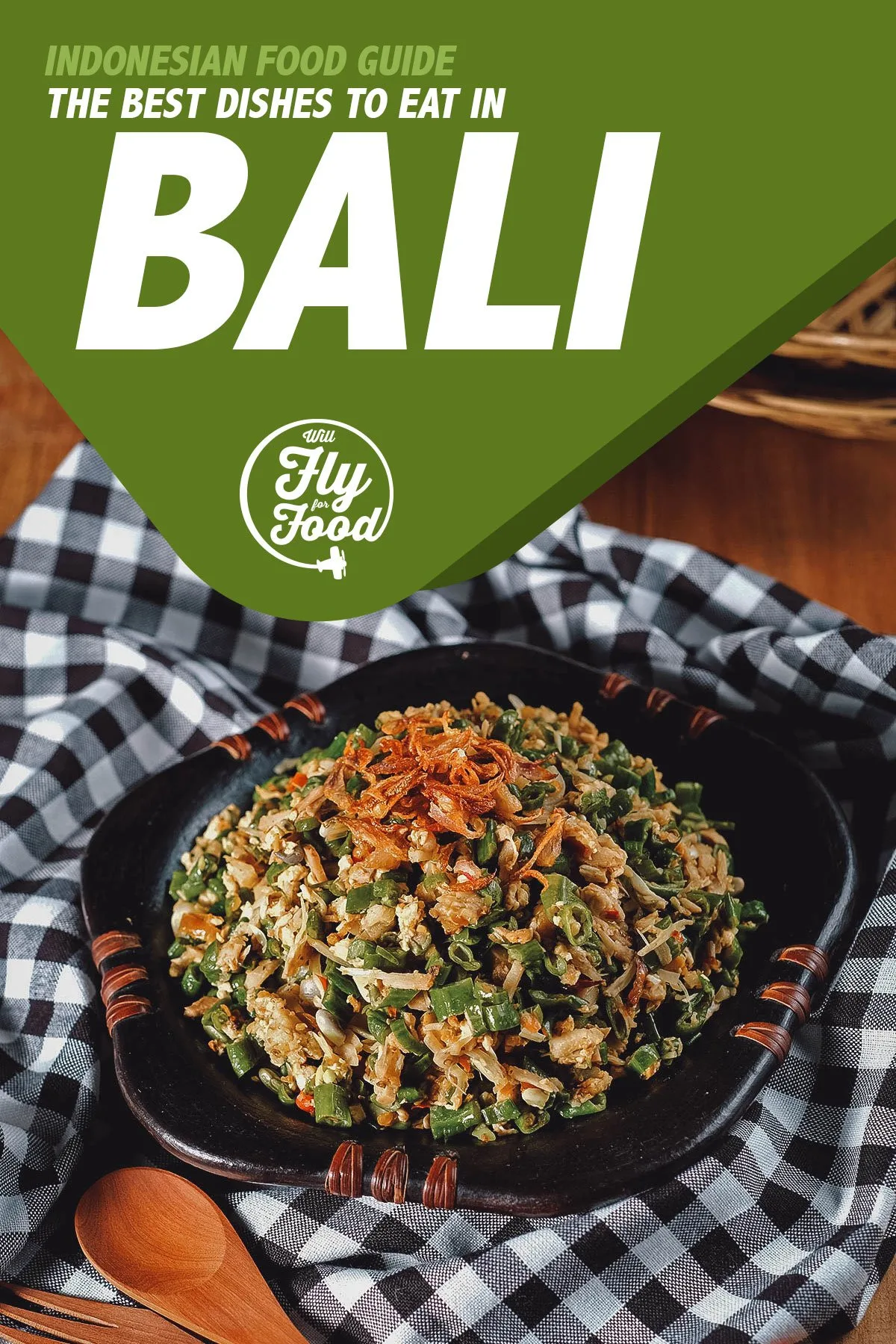
Photo by Ketut Mahendri
MUST-TRY BALINESE DISHES
1. Babi Guling
Babi guling or roast suckling pig is a traditional Balinese dish that breaks the norm of Indonesian cuisine. In other parts of Muslim Indonesia, pork isn’t available but you’ll find no shortage of it in Bali.
Usually a celebratory dish, babi guling was traditionally served only at religious ceremonies or large celebrations. With the growth of tourism however, this has changed and the dish is now regularly served at many Balinese restaurants.
The pig (babi) is marinated in spices and slow-roasted on a rolling (guling) spit over an open fire fueled by coconut husks or wood. When cooked, it’s served with steamed rice, vegetable salad, pork crackling, and a few other Balinese side dishes.
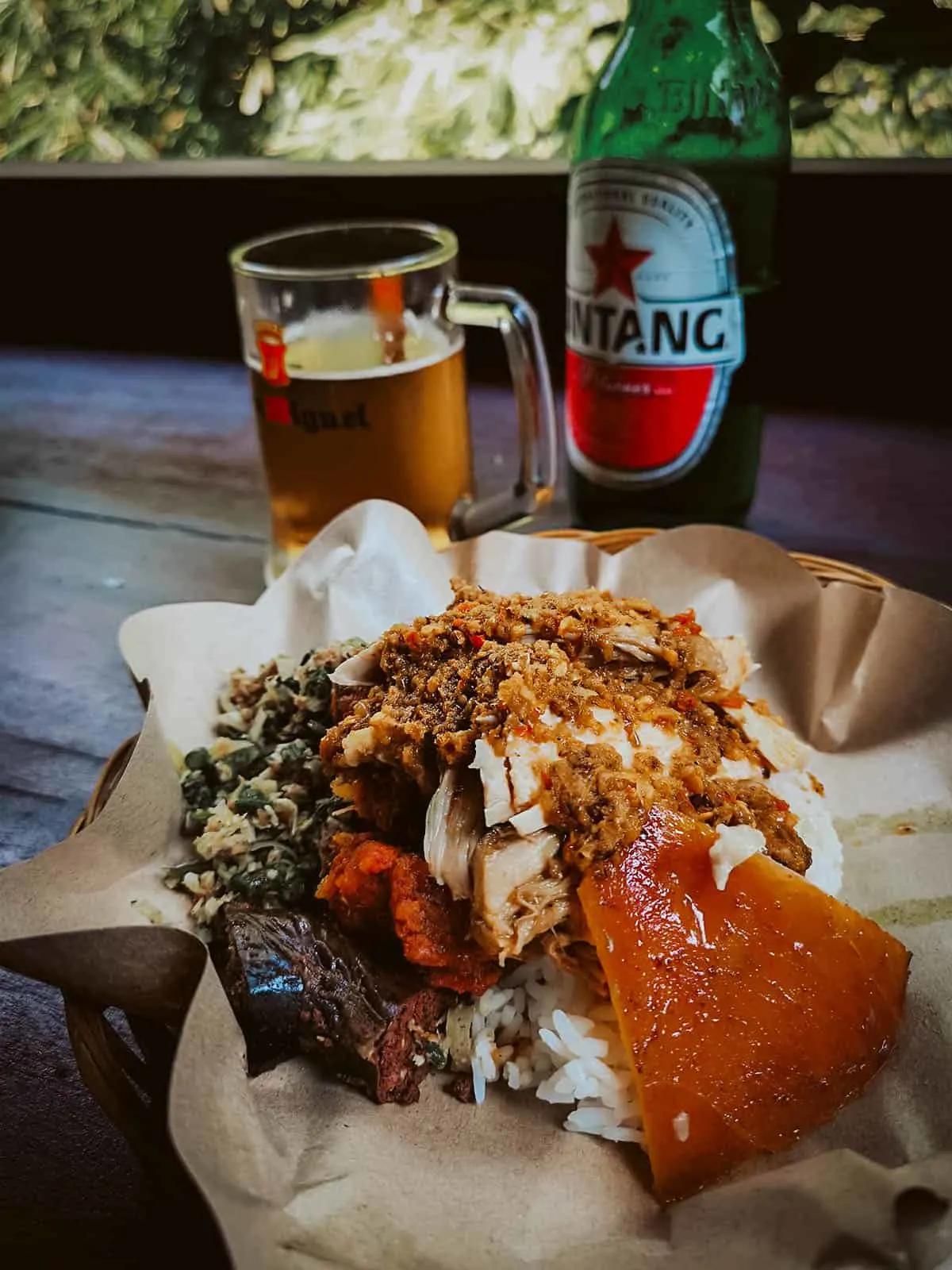
2. Nasi Campur Bali
A staple in Balinese cuisine, nasi campur bali is a rice meal consisting of steamed rice served with a variety of side dishes like grilled meat, shredded chicken, sate, tofu, tempe, bean sprouts, and sambal. It’s essentially a Balinese tasting platter with each chef and restaurant serving it a little differently.
While nasi campur is available throughout Indonesia, the unique blend of traditional spices found in many Balinese dishes is what makes this dish a must-try.
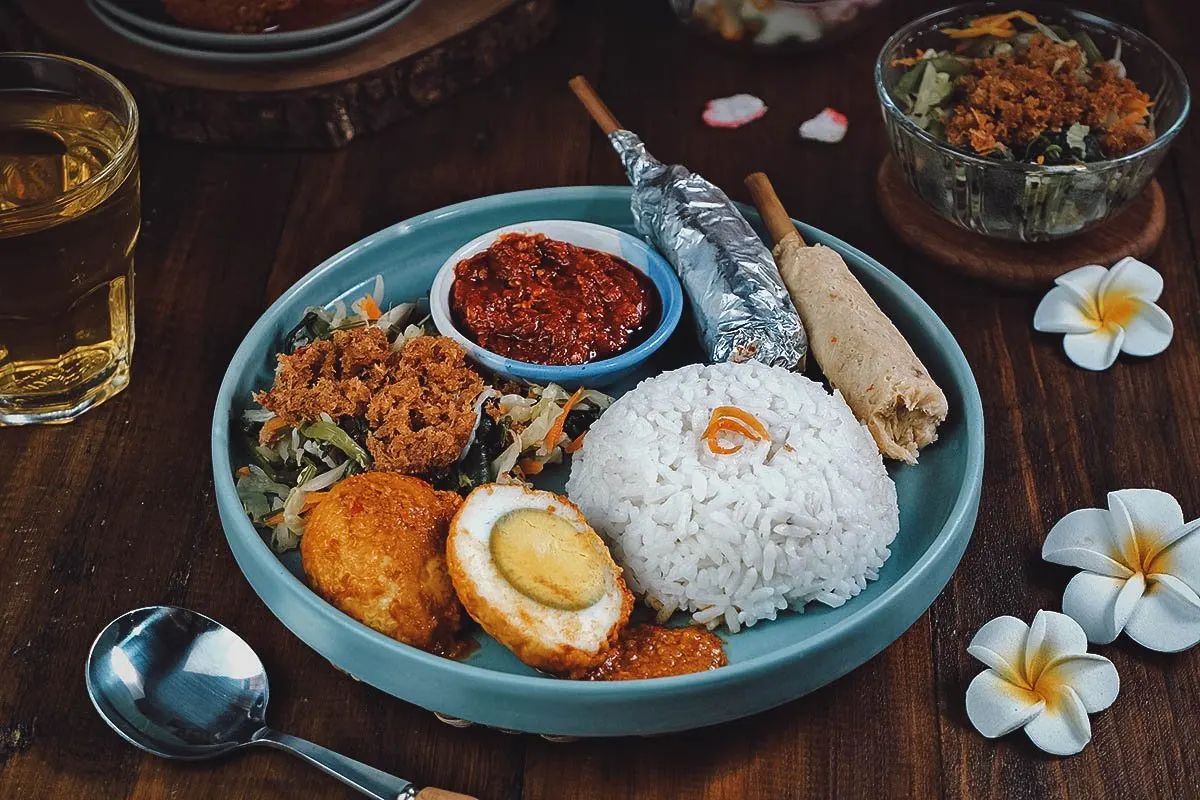
Photo by galuhtati
3. Tum Ayam
Tum is one of two dishes on this list that uses the technique of wrapping food in banana leaves. While pepes is the usual method, tum takes a slightly different form with the leaf stitched at one end.
Tum ayam contains a delightful mix of finely minced chicken flavored with herbs and spices. After being wrapped in banana leaves, the parcel is then steamed (or grilled) until the flavors permeate the entire dish.
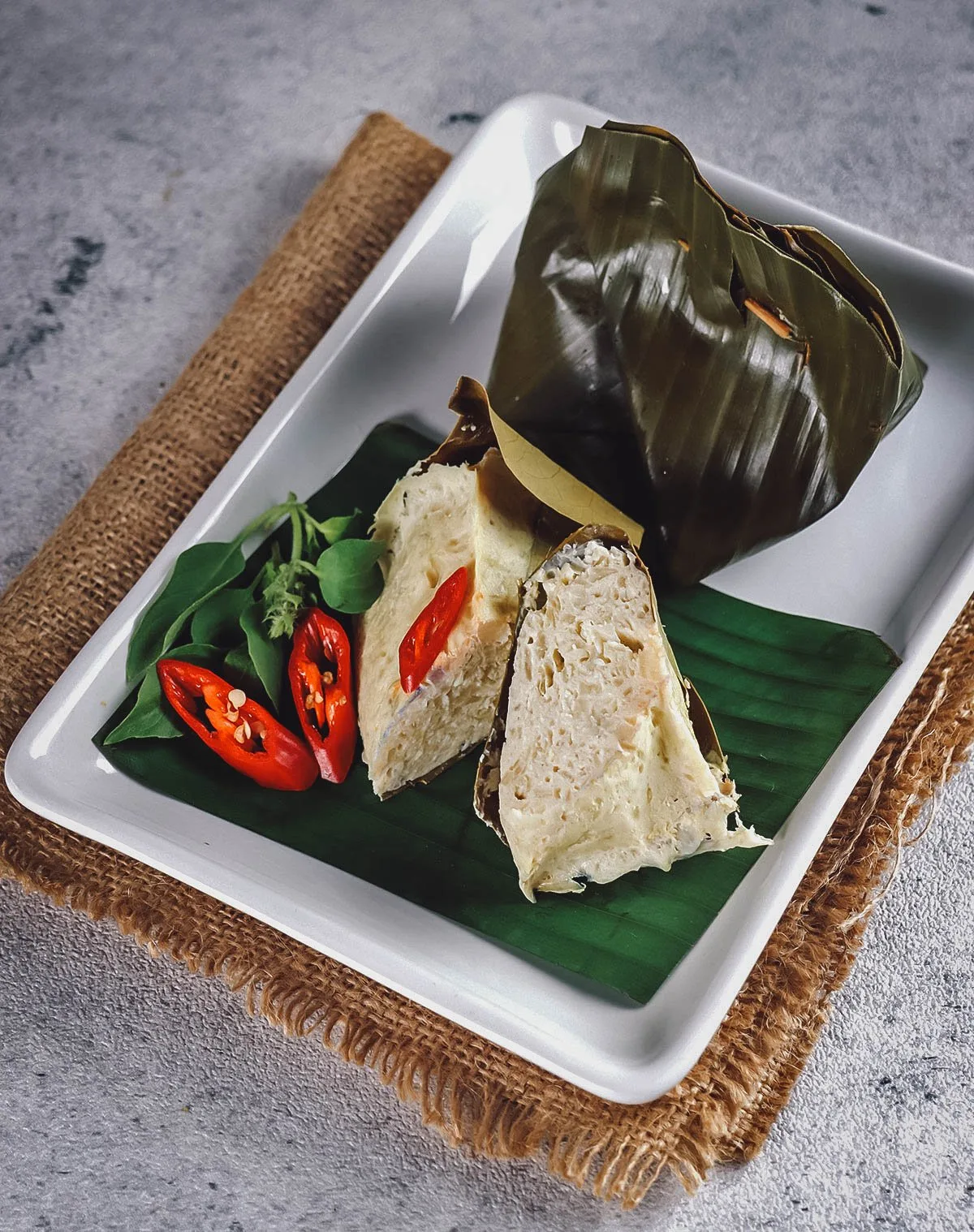
Photo by sri widyowati
4. Laklak
If you’ve ever had Japanese mochi or other sweet rice cakes, then this next dish is right up your alley. A traditional Balinese pancake, laklak is made with rice flour and usually comes in just one of two colors – white or green (from pandan leaves).
Typically eaten for breakfast or as a snack, laklak is harder to find in bigger cities but in Bali, it’s a common sight at many street food stalls. It’s served with a topping of melted palm sugar and grated coconut.
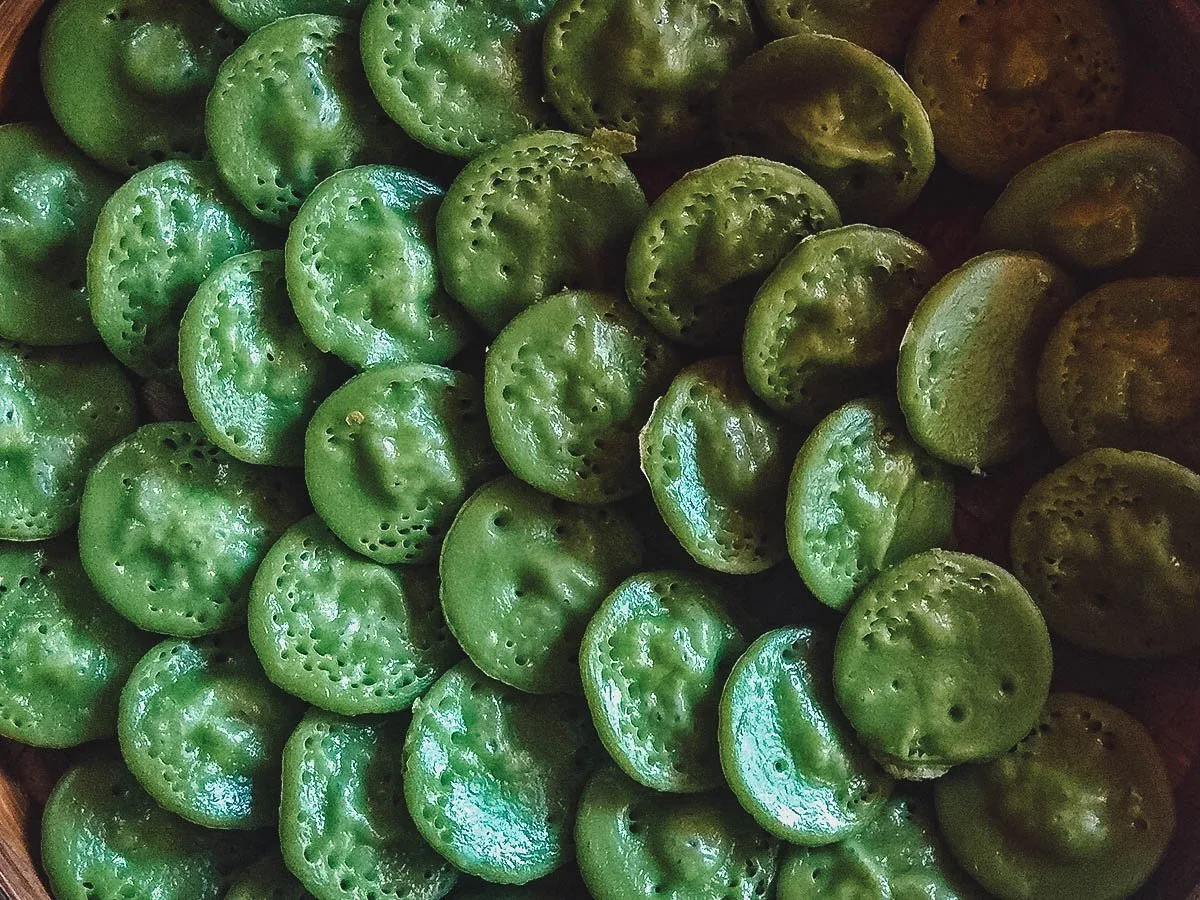
Photo by Pande Putu Hadi Wiguna
5. Jimbaran Seafood
Bali is surrounded by water so it’s no surprise that seafood is a favorite on the island.
You can find delicious seafood all throughout Bali, but one of the best places to enjoy a seafood feast is Jimbaran beach. All along the beach are restaurants and stalls selling a wide variety of fresh fish and seafood.
Many western tourists enjoy seafood on its own but personally, I like it best when paired with nasi goreng or Indonesian fried rice. If you like seafood, then this an experience that you absolutely cannot miss in Bali.
I suggest visiting Jimbaran beach in the late afternoon or early evening. You’ll find tables set up along the beach offering a spectacular view of the sunset.
Sunset and seafood on the Island of the Gods, what more can you ask for?
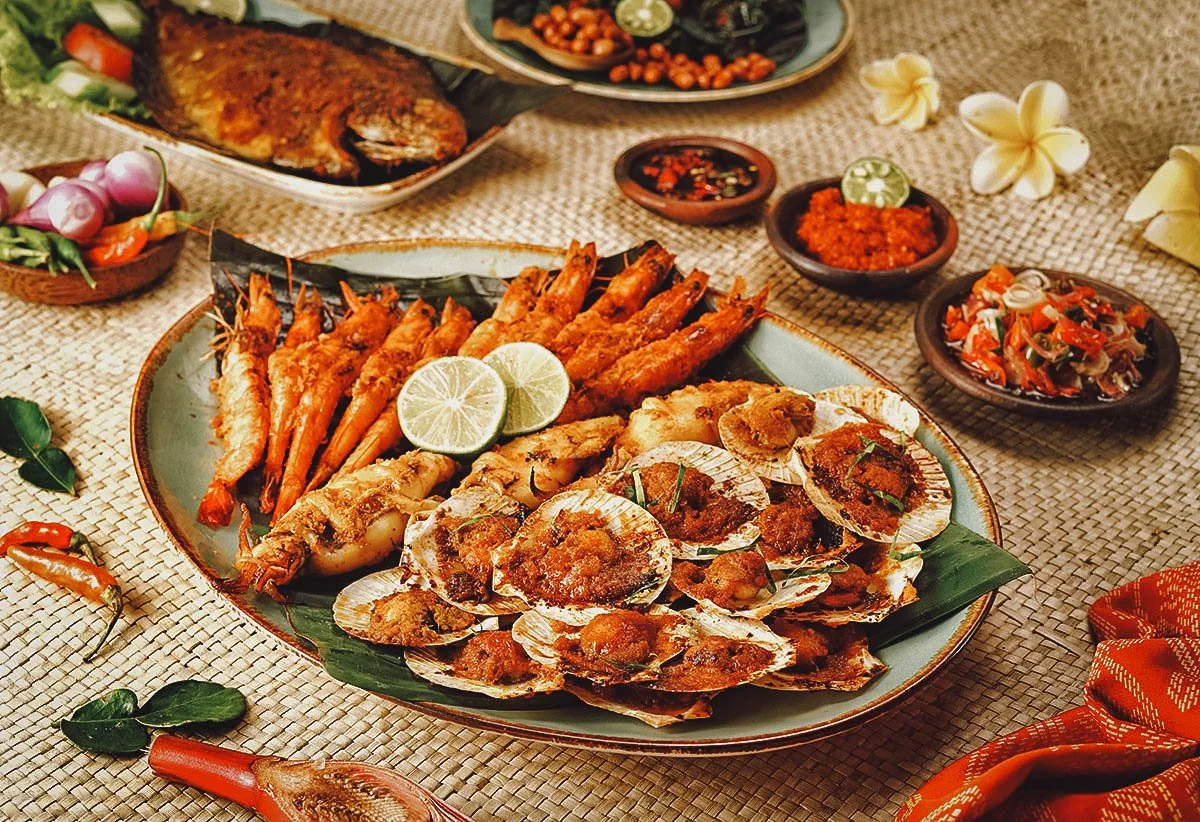
Photo by Hanifah Kurniati
6. Ayam Betutu
Originating from Gilimanuk, Bali’s harbor city, ayam betutu refers to a slow-cooked chicken (ayam) dish that is delightfully aromatic.
Perfect for those who don’t eat pork, ayam betutu consists of a whole chicken stuffed and seasoned with a special Balinese spice paste mixture. The bird is then wrapped in banana leaves and banana tree bark before being baked for 6-7 hours. Sometimes, it’s even cooked in the coal fire itself.
After cooking, the chicken meat is so juicy and tender that it separates effortlessly from the bone. The dish has a delightfully aromatic flavor that’s unlike anything you’ve experienced before.
If you prefer duck over chicken, then you’ll be pleased to learn that this dish comes in a duck version as well, called bebek betutu.
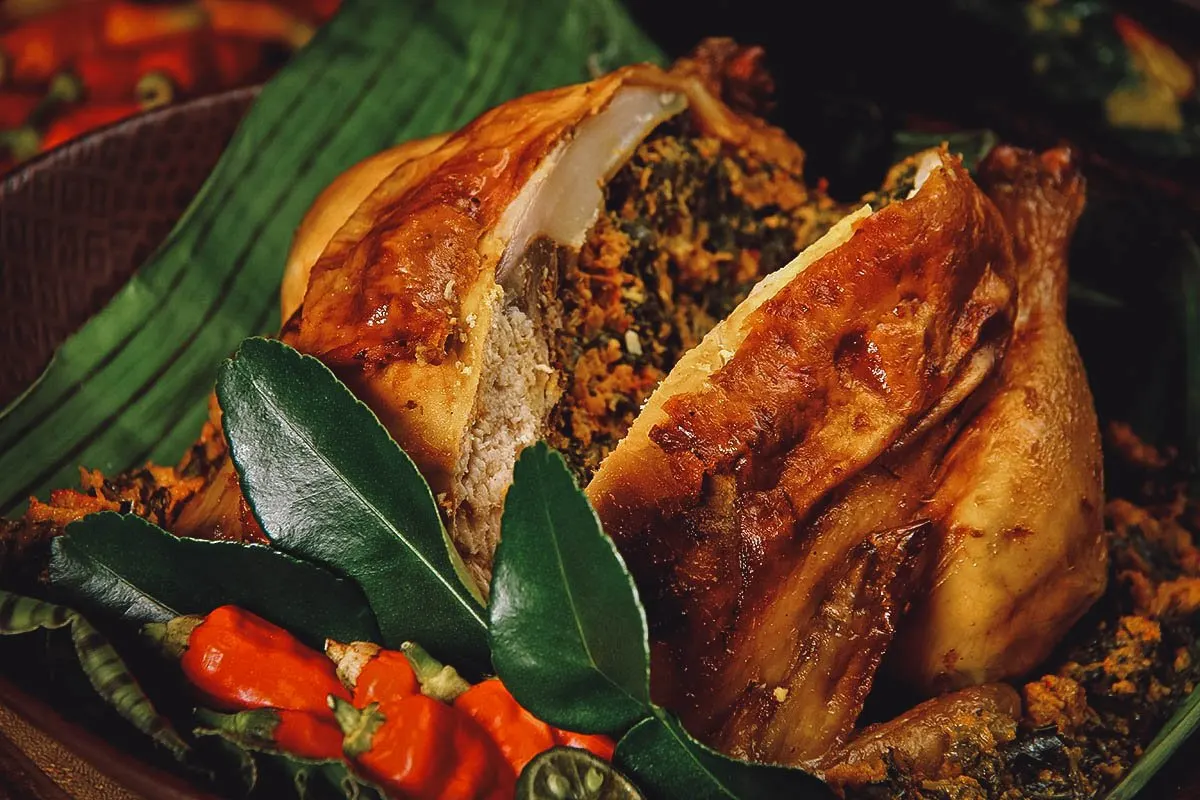
Photo by Ariyani Tedjo
7. Sambal Matah
Sambal matah is an important and often used Indonesian dressing/salsa in Balinese cuisine. The recipe varies from chef to chef but it’s typically made with garlic, chili peppers, lemongrass, and kaffir lime leaves. Sometimes, it can contain other ingredients as well like shrimp paste, shallots, and coconut oil.
Sambal matah is used as a base or marinade for many dishes in Bali. While it isn’t a dish per se, it’s something that you’re sure to come across often while enjoying the many delicious dishes in Bali.
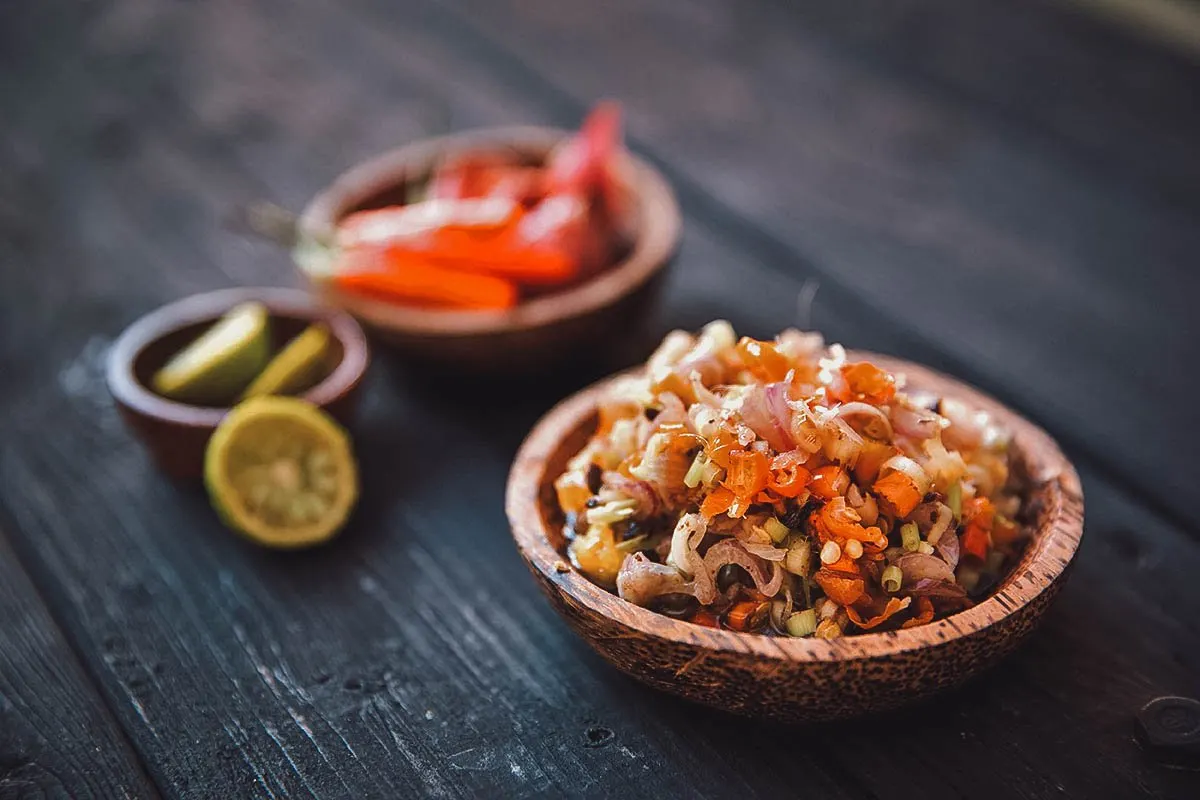
Photo by Odua Images
8. Sate
Sate (or satay) is one of the most recognizable dishes in Indonesian and Balinese cuisine. These skewers of grilled meat are a staple in Bali with many varieties available.
Sate lilit (wrap) refers to meat that’s been finely diced, marinated in coconut milk and spices, and then wrapped around sticks instead of being skewered. It can be made with different types of meat and is perhaps a different take on the sate that many people are familiar with. Unlike the usual sate that’s served with peanut sauce, sate lilit isn’t usually served with a sauce.
Sate plecing is a type of pork sate that’s served with a special sauce called sambal plecing. Sambal plecing is a variation of sambal matah. It’s typically made with chili peppers, shrimp paste, tomatoes, onions, and garlic. Sometimes, it can be made with sugar for a sweeter flavor.
Sate pentul is similar to sate lilit in that it’s made with minced meat – typically fish – wrapped around a stick. However, instead of the traditional bamboo stick used in lilit, pentul is wrapped around rolled-up lemongrass stems. It’s also served with grated coconut for even more aroma and flavor.
This is just a brief overview of the many different types of sate you can find in Bali. If you have a taste for sate like I do, then you’ll have no problem finding many more in Bali.
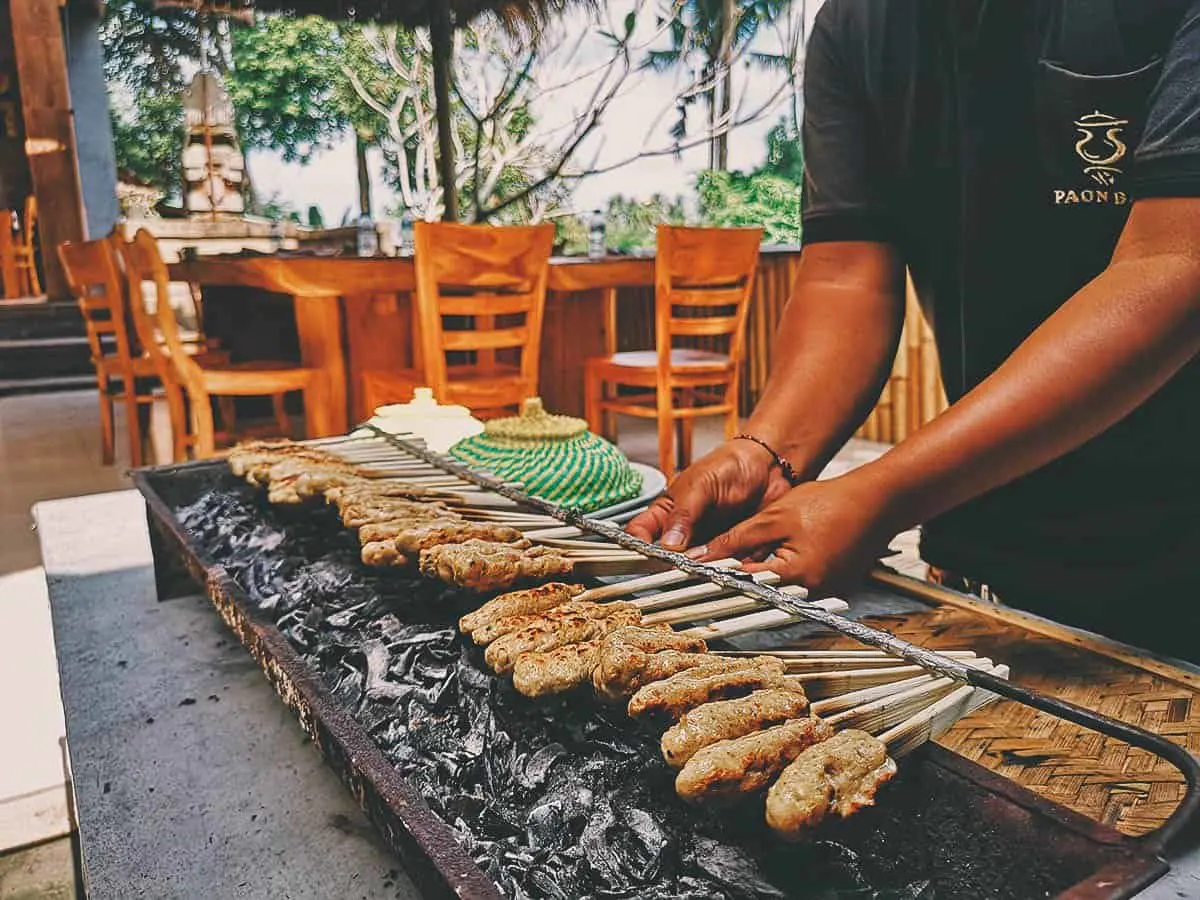
9. Lawar
Lawar will blow you away with its flavors. A staple dish at warungs (traditional restaurants), it’s typically made from ground meat, sliced green vegetables, and grated coconut, though some versions are made with animal blood as well to strengthen its flavor.
This is known as red lawar and tends to have an unami-savory taste. Because it contains animal blood, this type of lawar needs to be served and consumed immediately.
Red lawar is best reserved for those with more daring palates. If you’d prefer a vegan or vegetarian option, then you’ll be pleased to learn that there’s a white version of lawar that doesn’t contain meat or blood. Instead, it’s made with jackfruit.
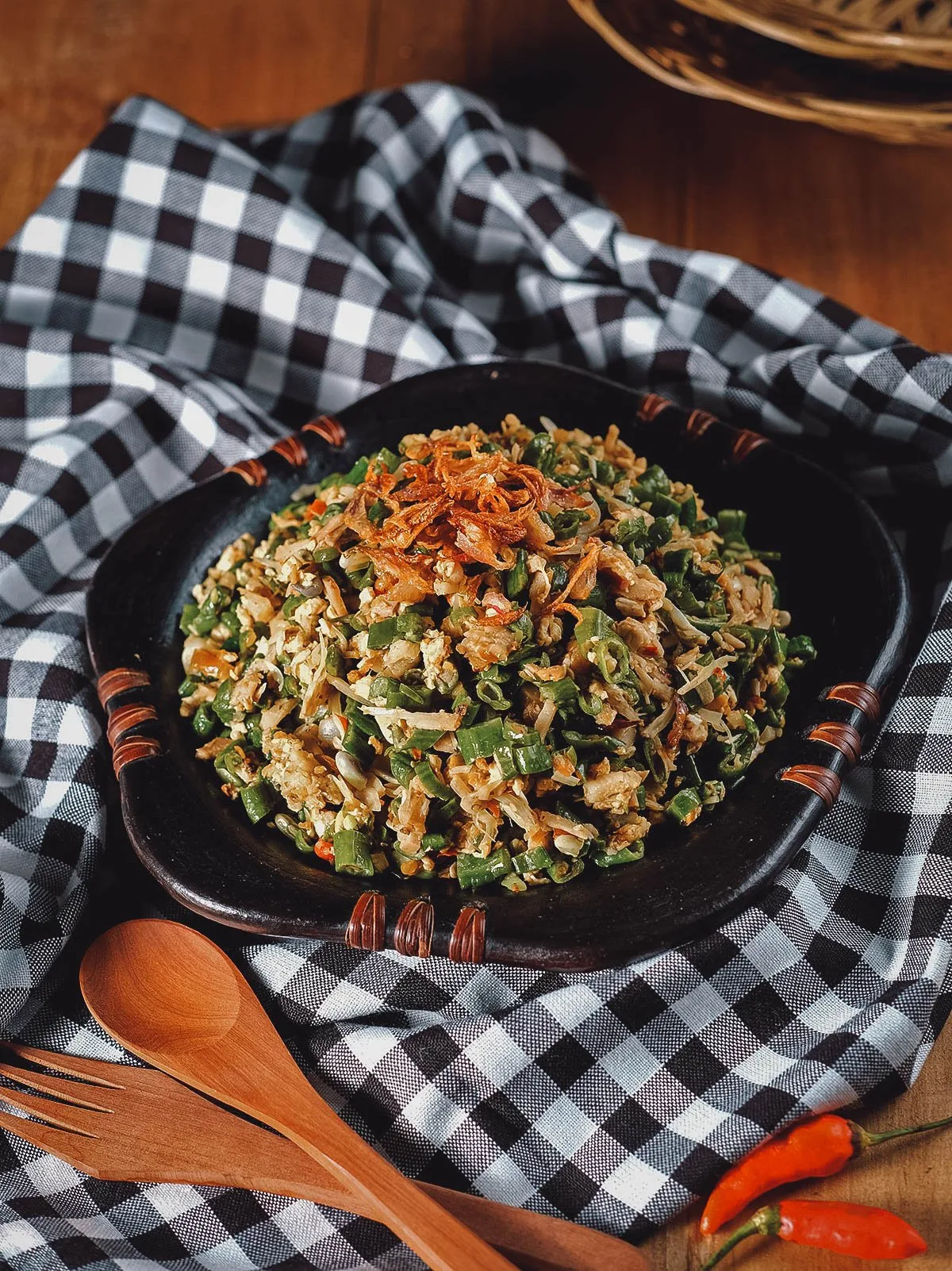
Photo by Ketut Mahendri
10. Pepes Ikan
As stated previously, pepes is the method of cooking food wrapped in a banana leaf. It’s most commonly used to cook fish in a dish called pepes ikan.
Unlike tum, the food isn’t minced and the banana leaf is sealed with bamboo sticks rather than being stitched closed. Ikan refers to the fish which is left whole and marinated before being wrapped in the banana leaf and steamed. This method of cooking allows the fish to fully absorb the flavors and aromas that have come to be associated with Balinese cuisine.
Any fish can be used to make pepes ikan but it’s most commonly made with mackerel, sardines, or snapper. This delicious dish will give you an authentic taste of Bali that you probably can’t find anywhere else.
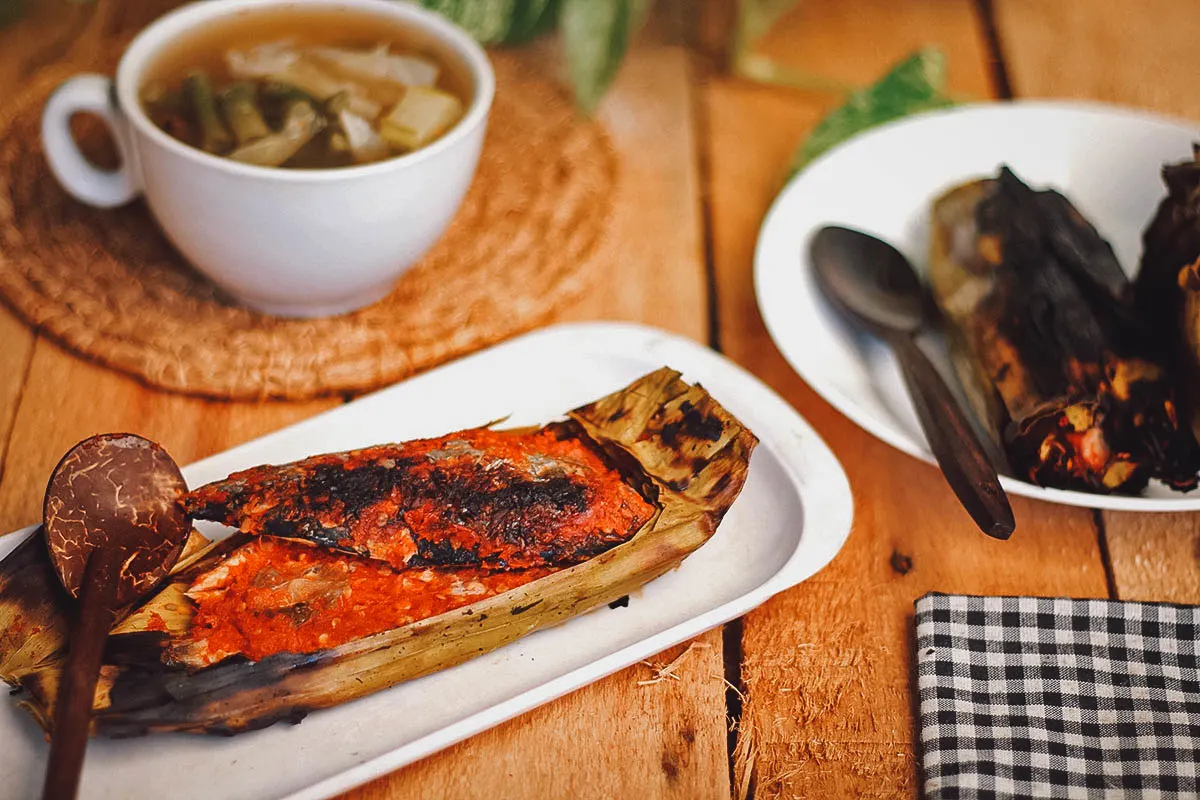
Photo by Diade Riva Nugrahani
BONUS: Jamu
Balinese food is delicious but it feels wrong to leave out this healthy and refreshing multi-vitamin juice drink called jamu. It’s made from fresh turmeric root, ginger, and newly-soaked white rice that’s been ground and served with warm water, lime juice, and honey. It may not be for everyone but it’s definitely worth trying at least once.
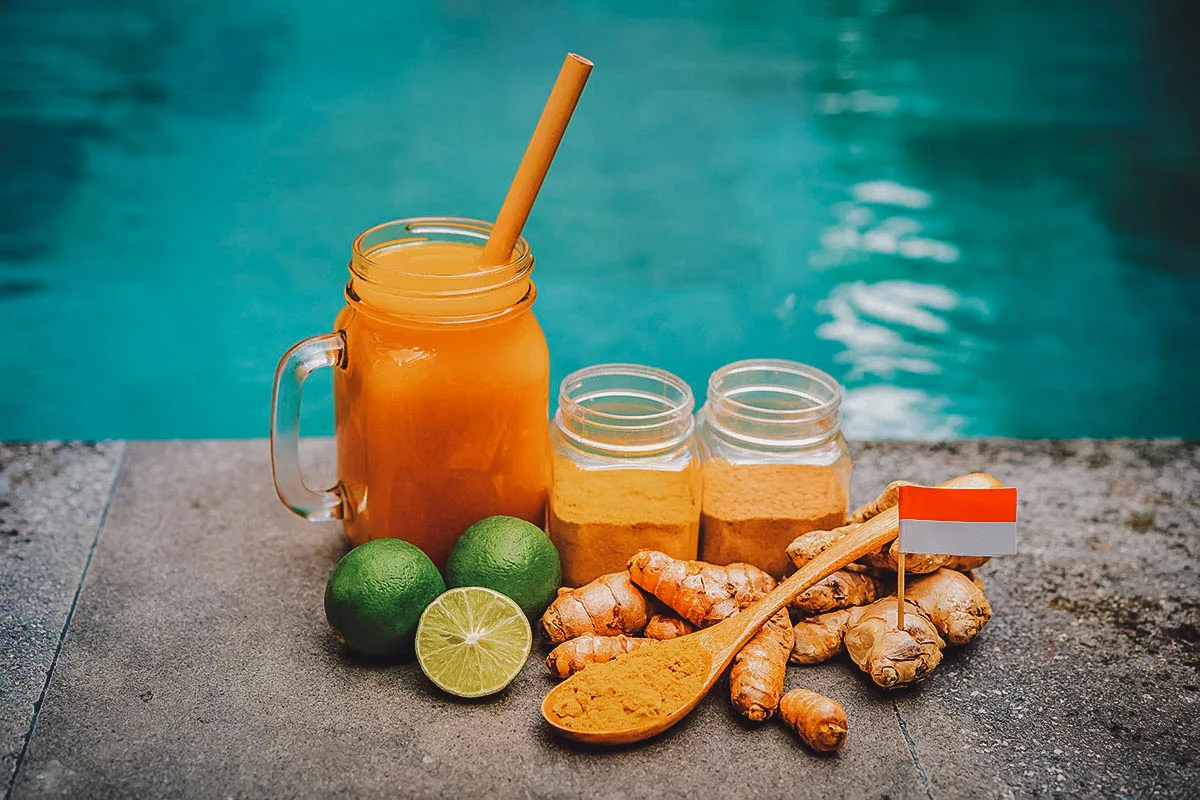
Photo by Elizaveta Galitckaia
FINAL THOUGHTS ON TRADITIONAL BALINESE CUISINE
Overall, Balinese cuisine is a melting pot of flavors that’s underpinned by the unique aromatic spice blends they use. The food changes depending on where you are in the province and it truly does present a different gustatory experience from the rest of Indonesia.
Whether it’s street food like laklak or sate, more substantial meals like babi guling or nasi campur, or just the underlying flavors of sambal matah – there’s sure to be something in Bali to entice and please your palate.
If we had to trim this list down even further, then we would definitely say that babi guling and ayam betutu are the must-try dishes. You can’t find them anywhere else and they’re made with interesting and unique cooking techniques.
However, this list offers just a small taste of all the delightful food experiences you can have in Bali. It’s worth going beyond the touristy parts of the island and exploring the traditional markets to get a truer sense of what authentic Balinese cooking is like. Happy travels.
About the Author
Jenny Han is a writer for Essayroo and Assignment Writing Services and blogs for Big Assignments. She enjoys writing about travel when she can.
Disclosure
Some of the links in this Balinese food guide are affiliate links. What that means is that we’ll make a small commission if you make a booking or reservation at no extra cost to you. As always, we only recommend products and services that we use ourselves and firmly believe in. We really appreciate your support as it helps us make more of these free travel and food guides. Thank you!
Cover photo by galuhtati. Stock images via Shutterstock.

